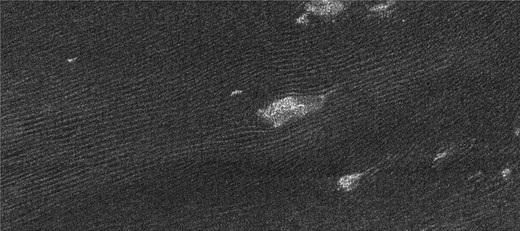Even before the Cassini spacecraft entered the Saturn system, scientists were predicting that Saturn’s moon Titan would be quite Earth-like. And every image that’s been returned of Titan’s clouds, lakes, rivers, and other landforms is proving them right. In 2005 Cassini’s imaging radar discovered a massive area of sand dunes around Titan’s equatorial region. Although these dark, windblown dunes look much like sand dunes on Earth (they’ve been compared to mountainous drifts of coffee grounds), scientists are finding that the dunes are likely made of organic molecules that are not anything at all like sand.
Titan is known to have massive amounts of hydrocarbons. New observations of Titan’s sand dunes raise the possibility that much of the sand grows from hydrocarbon particulates fallen from Titan’s thick atmosphere. Once on the ground, the particulates join together and become sand grain-size particles.
This process is called sintering – where the particles are heated enough to melt together. Scientist Jason W. Barnes of NASA’s Ames Research Center says that this sintering may produce particles that are about the same size as sand grains – between 0.18-0.25 millimeters, which are perfect for blowing in the wind and drifting into dunes.
So, this process is quite the opposite of what happens to sand on Earth, which comes from silicates, gypsum, or rock that have broken down to finer grains. But on Titan, the small hydrocarbon particulates grow together into larger grains. Barnes says the process is extremely slow, but Titan has been around long enough for this to have occurred.
Based on measurements from Cassini, the dunes are 100-200 meters high and are between 1 and 79 kilometers long. Not all over Titan’s surface has been imaged, but scientists believe up to 20 % of Titan’s surface could be covered by these hydrocarbon dunes.
Original News Source: JPL


I’m sorry but I would’nt want to live next to an ocean of gas
I always knew that “Titan” would be just like Earth.
I wonder if we can build a colony there?
Wouldn’t a more accurate analogy be snow? It’s formed more of the same way. And it does blow around it drifts as well.
@shepard:
At -180 degrees C, a colony wouldn’t be very viable, besides the fact that’s it’s almost compeltely dark to the human eye there.
@Bigdon:
No snow is not an analogy, because snow sublimates from gas form to become solid.
The often repeated claim that the dunes of Titan are organic is based upon the fact that they are not primarily water, and are assumed to have a bulk density of a full moon, and even during many of the nights there is dim lighting through ‘Saturn shine.”
The often repeated claim that the dunes of Titan are organic is based upon the fact that they are not primarily water, and are assumed to have a bulk density of < 1. It is better to say the compostion is unknown – we really do not know what those dunes are made of.
***
At midday, the Sunlight on Titan is brighter than a full moon, and even during many of the nights there is dim lighting through ‘Saturn shine.”